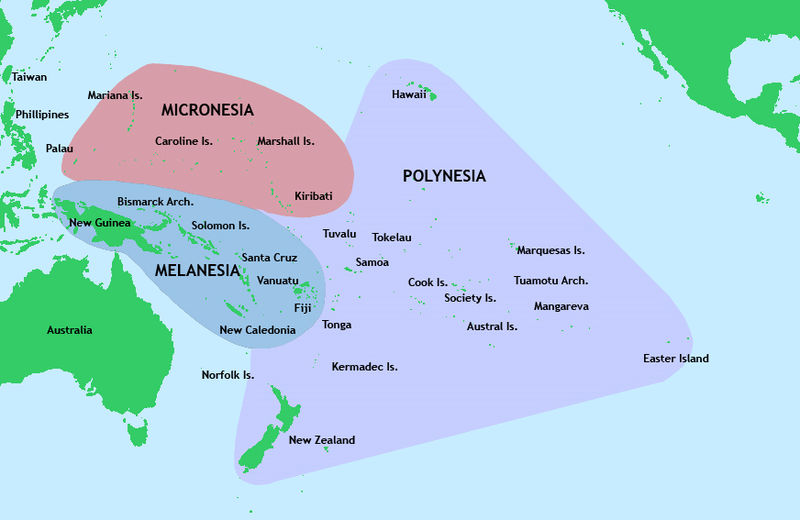Surprising new evidence which overturns current theories of how humans colonised the Pacific has been discovered by scientists at the University of Leeds.
The islands of Polynesia were first inhabited around 3,000 years ago, but where these people came from has long been a hot topic of debate amongst scientists. The most commonly accepted view, based on archaeological and linguistic evidence as well as genetic studies, is that Pacific islanders were the latter part of a migration south and eastwards from Taiwan which began around 4,000 years ago.
But the Leeds research - published today in The American Journal of Human Genetics - has found that the link to Taiwan does not stand up to scrutiny. In fact, the DNA of current Polynesians can be traced back to migrants from the Asian mainland who had already settled in islands close to New Guinea some 6-8,000 years ago.
The type of DNA extracted and analysed in this kind of study is that stored in the cell's mitochondria. Mitochondrial DNA (mtDNA) is passed down the maternal line, providing a record of inheritance which goes back thousands of years. The scientists look for genetic signatures which enable them to classify the DNA into different lineages and then use a 'molecular clock' to date when these lineages moved into different parts of the world.
Lead researcher, Professor Martin Richards, explains: "Most previous studies looked at a small piece of mtDNA, but for this research we studied 157 complete mitochondrial genomes in addition to smaller samples from over 4,750 people from across Southeast Asia and Polynesia. We also reworked our dating techniques to significantly reduce the margin of error. This means we can be confident that the Polynesian population - at least on the female side - came from people who arrived in the Bismarck Archipelago of Papua New Guinea thousands of years before the supposed migration from Taiwan took place."
Nevertheless, most linguists maintain that the Polynesian languages are part of the Austronesian language family which originates in Taiwan. And most archaeologists see evidence for a Southeast Asian influence on the appearance of the Lapita culture in the Bismarck Archipelago around 3,500 years ago. Characterised by distinctive dentate stamped ceramics and obsidian tools, Lapita is also a marker for the earliest settlers of Polynesia.
Professor Richards and co-researcher Dr Pedro Soares (now at the University of Porto), argue that the linguistic and cultural connections are due to smaller migratory movements from Taiwan that did not leave any substantial genetic impact on the pre-existing population.
"Although our results throw out the likelihood of any maternal ancestry in Taiwan for the Polynesians, they don't preclude the possibility of a Taiwanese linguistic or cultural influence on the Bismarck Archipelago at that time," explains Professor Richards. "In fact, some minor mitochondrial lineages back up this idea. It seems likely there was a 'voyaging corridor' between the islands of Southeast Asia and the Bismarck Archipelago carrying maritime traders who brought their language and artefacts and perhaps helped to create the impetus for the migration into the Pacific.
"Our study of the mtDNA evidence shows the interactions between the islands of Southeast Asia and the Pacific was far more complex than previous accounts tended to suggest and it paves the way for new theories of the spread of Austronesian languages."
The study, which involved researchers from the UK, Taiwan and Australia, was mainly funded by the British Academy, the Bradshaw Foundation and the European Union.
Professor Richards is available for interview. Please contact:
Jo Kelly, Campus PR Ltd: Tel 0113 258 9880, Mob 07980 267756, email jo@campuspr.co.uk
Notes to editors:
- The report: Ancient voyaging and Polynesian origins appears in The American Journal of Human Genetics, ref: AJHG-D-10-00957R2, Richards, published online 3 February 2011. A copy of the paper is available from Cell Press: Elisabeth Lyons, press officer, email elyons@cell.com , tel +1 617 386 2121.
- Professor Martin Richards holds a chair in Archaeogenetics in the Institute of Integrative & Comparative Biology at the Faculty of Biological Sciences, University of Leeds. He also leads the Faculty's Archaeogenetics Research Group which studies the geographic distribution of modern human genetic variation, with the aim of addressing questions from archaeology, anthropology and history.
Professor Richards' main collaborator on this research was Dr Pedro Soares, formerly of the University of Leeds and now at the Institute of Molecular Pathology and Immunology of the University of Porto (IPATIMUP). - The research was mainly funded by the British Academy, the Bradshaw Foundation, and a European Union Marie Curie Early Stage Training Grant, with additional funding through the de Laszlo Foundation, the National Science Council of Taiwan, grant (NSC96-2627-H-195-001), the National Health Research Institute of Taiwan (grant: NHRI-EX94-9218BI) and an FCT grant (SFRH/BPD/64233/ 2009).
- The Faculty of Biological Sciences at the University of Leeds is one of the largest in the UK, with over 150 academic staff and over 400 postdoctoral fellows and postgraduate students. The Faculty is ranked 4th in the UK (Nature Journal, 457 (2009) doi :10.1038/457013a) based on results of the 2008 Research Assessment Exercise (RAE). The RAE feedback noted that "virtually all outputs were assessed as being recognized internationally, with many (60%) being internationally excellent or world-leading" in quality. The Faculty's research grant portfolio totals some £60M and funders include charities, research councils, the European Union and industry.
- The University of Leeds is one of the largest higher education institutions in the UK with more than 30,000 students from 130 countries. With a turnover approaching £450m, Leeds is one of the top ten research universities in the UK, and a member of the Russell Group of research-intensive universities. It was placed 80th in the 2007 Times Higher Education world universities league table. The University's vision is to secure a place among the world's top 50 by 2015.




Reader Comments
to our Newsletter